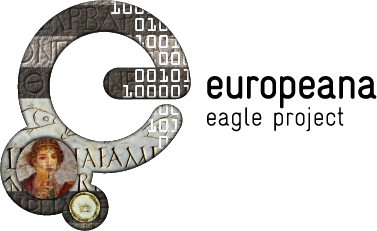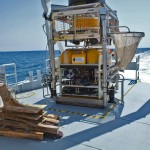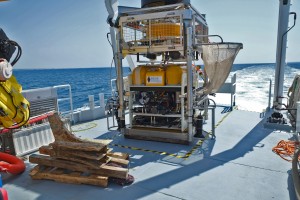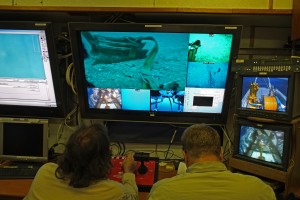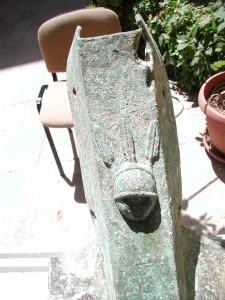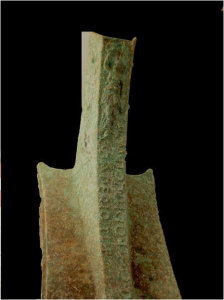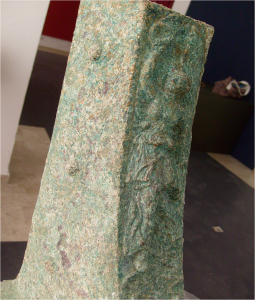Inscription from Phorbantia (Aegates Insulae)
- Trismegistos-Id: 698150
- Material: aes
- Type: arma rostrum navale
- inscriptionType: cetera probatio
- originDating: -264 BC - -241 BC
- findingSpotAncient: Phorbantia (Aegates Insulae), Sicilia cum insulis
- findingSpotModern: Levanzo (Isole Egadi), Italia
- debug: Curl error: (22) The requested URL returned error: 503 Service Unavailable | http://epidoc.dainst.org/
- entityType: visual
- Repository: Epigraphic Database Roma
Inscription from Phorbantia (Aegates Insulae)
- Trismegistos-Id: 674854
- Material: aes
- Type: arma rostrum navale
- inscriptionType: cetera probatio
- originDating: -264 BC - -241 BC
- findingSpotAncient: Phorbantia (Aegates Insulae), Sicilia cum insulis
- findingSpotModern: Levanzo (Isole Egadi), Italia
- debug: Curl error: (22) The requested URL returned error: 503 Service Unavailable | http://epidoc.dainst.org/
- entityType: visual
- Repository: Epigraphic Database Roma
This is the story of a young quaestor, Lucius Quinctius, who held the post during the first Punic War. We do not know if after this step of the cursus honorum, he accomplished other successes, but his rediscovered name is now inextricably linked to the Battle of the Egadi
This is also the story of his colleagues: Marcus Publicius and Caius Papirius; their names too are connected to the same war landscape, to the same service as officers of the Roman Republic..
The Battle of the Egadi was the final naval battle fought on 10 March 241 BC off the Aegadian Islands,
off the western coast of Sicily, that marked the Roman victory and the end of a twenty-year conflict with the Carthaginians, ratifying the supremacy of Rome over the Mediterranean , so far only known through ancient sources, such as Polybius.
A joint project (Egadi Survey Project) directed since 2005 through the cooperative efforts of two institutions, the Soprintendenza Del Mare, Regione Sicilia, and the RPM Nautical Foundation, confirm the naval battle’s general location off Capo Grosso of Levanzo with multiple finds of bronze warship rams, helmets, and amphoras,
destined for a Carthaginian garrison on Sicily. The finds from the Egadi Islands provide archaeological evidence for the key naval battle described by Polybius that ended the First Punic War in 241 B.C., a crushing defeat for the Carthaginians which launched Rome on its path of expansion.
Prior to the Egadi Survey Project, warship rams were an extremely rare artifact, with only three
waterline rams known, and only one of them , the Athlit ram, recovered from an archaeological context. To date, the project has found 8 new examples, 5 of which display, extended on the upper surface of the ram’s cowl, latin inscriptions (now in the EAGLE Database) celebrating, with the help of molded decorations, a quaestor or two; celebrating the efforts of specific officials who oversaw fleet financing. [recupero rostro su nave Hercules RPM – video S.Emma, Soprintendenza del Mare]
Who were the quaestors in ancient Rome?
The office of quaestor was adopted as the first official post of the cursus honorum. By achieving election as quaestor, a Roman man would earn the right to sit in the Senate and begin to progress along the standard sequence of offices that made up a career in public service. So quaestorship became the first magistracy sought by an ambitious young man. The order of advancement through elected offices in Republican Rome was known as the cursus honorum, the sequential order of public offices held by aspiring politicians in both the Roman Republic and the early Empire. It was designed for men of senatorial rank. The cursus honorum comprised a mixture of military and political administration posts. Each office had a minimum age for election: the quaestor candidate had to be at least 28. Minimum intervals (two years) had to elapse between the end of one office and the beginning of the next step on the cursus honorum and laws forbade repeating an office. To have held each office at the youngest possible age (suo anno, “in his year”) was considered a great political success, since to miss out on a single step meant that one could not become consul at 42!
The earliest origins of the office are obscure: this magistrate is first mentioned in the Laws of the Twelve Tables, although there are reports about quaestors who served under the rule of the Roman kings. The term “quaestor”, comes from “quaero” “to investigate” “to asks questions” , and initially their task was to investigate murder cases; in fact, they were some kind of police inspectors, quaestores parricidii (quaestors with judicial powers ). The office came into prominence with the advent of the Republic around 509 BC when the two consuls (appointing one each) placed quaestores aerarii in control of the public treasury or aerarium. Around 450 BCE, when plebians became eligible for the office, their number was increased to four, and with that, the position be-came a widely sought job by many young, ambitious men, because one was expected to become a very important official. Two quaestors served as quartermasters to the two consuls when they were in the field, and the other two stayed in Rome to supervise the financial affairs of the treasury. After 440 BC they were no longer appointed by the consuls and were, instead, chosen each year by the Comitia Tributa, the assembly of the 35 tribes.
After 267 BC the number was expanded to eight. As with their number, their official function changed over the years Some quaestors were assigned to work in the City, while others were assigned to the staffs of generals or served as lieutenant governors in the provinces. Still others were assigned to oversee military finances. Their newly expanded duties included collecting taxes and tributes from the territories as well as recruiting new soldiers for service in the army. Eventually, each provincial governor would have his own quaestor.
The names of Lucius Quinctius , alone, and those of Marcus Publicius and Caius Papirius, always together, extend on the surface of the naval rams certifying the probatio. Although the gens Quinctia is an ancient Roman family that originates, according to tradition by Livius, in the reign of T. Hostilius, with many prominent figures among its members, such as L. Quinctius Cincinnatus, the famous dictator known for his sense of the Res Publica and his uncorrupted attachment to the ancient and simple traditions of Rome, none of the known figures in the third century BC however, seems to correspond to our L. Quinctius.
Among the three, the character that has left more traces in history is Marcus Publicius, that can be identifiable with a consul mentioned in the Fasti consulares for the year 232 BC
The gens Publicia reached a certain importance in the years between the First and Second Punic War, splitting into two branches: Malleolus and Bibilus. And the first member of this gens to reach the consulate was M. Publicius Malleolus in 232 BC, along with Lepidus and it could be exactly our Marcus Publicius, who at the time of the Battle of the Egadi was a young quaestor and years later, suo anno, made it to the most important position. We also know that this consul Publicius was sent with his colleague Lepidus in Sardinia, but both were later robbed in Corsica of their earned plunder. That’s life!
Each naval ram inscription is accompanied by a figurative motif in relief, not only in order to improve the aesthetics and increase the value, but also to enhance its commemorative value, in line with the content of the inscription and the type of the object.
On Lucius Quinctius’ rams is reproduced a helmet of the type called “montefortino“, used both by Samnites, Romans and other Italic peoples to the first century BC.
The relief decoration reproduces the military headgear with extreme attention to details: well defined are the jowl protections, that cover the lower part of the face, the ridge of the brim, the apex and the three straight feathers, which branch off from it. The details of the three feathers is significant as sources hand down the use to decorate the top of the helmets with three red or black swan feathers, straight on the top, with a length of about a cubit, so the soldier who wore it seemed much higher, and the sight of the enemy appeared more majestic and terrible at the same time.
The helmet motif is the defensive weapon that more often appears in Roman, both public and private, friezes of arms. The montefortino helmet is a simple infantry helmet, that we find especially in the Tomb of the Reliefs of Cerveteri. The propaganda of the Hellenistic rulers often used the image of a soldier with a helmet associated with the bow of a victorious ship. and also the Atlit ram has among its decorations a helmet.
The inscription of the two quaestors , Marcus Publicius and Caius Papirius, is topped with a relief decoration of a winged female figure,
holding in her raised right hand a crown and, a long palm branch with the other arm stretched out along the body; she wears a chiton without sleeves, held tight to the body by a band crossed over her breasts and stopped by a boss; the harmony of proportions, the discrete technical skill in the use of chiaroscuro, the grace of the female forms suggest that our figure is a representation of Victory inspired by well-known archetypes of the Classical and Hellenistic era (Nike of the Messeni and Naupactus, masterpiece by Paionios of Mende of 425 BC), translated, undoubtedly, into an Italic simplified and somewhat naive language, but still revealing a fairly accurate knowledge of Greek prototypes. This decoration is the only embellishment of the entire object and is in a prominent position. In the Republican era it is common to find coins with a winged Victoria holding a wreath in her right hand, sometimes a palm branch in her left: Victoria is a military deity, tied to the fate of the weapons and guarantor of their power and integrity. Therefore, it’s not a surprise to find this image to seal the realization of a weapon of great destructive power that has greatly contributed to the success of the Romans.
The names emerged from the investigations off the Egadi not only fill in gaps in the lists of the already known Roman magistrates, but allow to connect the duties of these quaestores classici with the fleet, the administration of the naval armament and with the decision of the Senate (according to Polybius) on 243 BC ca., to build more powerful ships for the fleet through a loan requested by the state to individuals, a loan requiring to be documented and managed by state offiicials.
From the set of all epigraphic evidence from the Egadi rams seems to be emerging among the positions of the quaestores classici an exclusive competence in the operation of probatio indicated in the latin inscribed rams; both individually, and in pairs, they monitor the progress of the loan and guarantee the correctness of related operations, as well as the authentication of naval elements whose construction was made possible by the loan itself. In this case Publicius, Papirius and Quinctius could be quaestors – certifiers, while it still is unclear, with the data currently available, exactly what operations can refer to these officials, that is, if they followed the steps of the construction of the fleet or simply affixed their mark on each single weapon of destruction.
